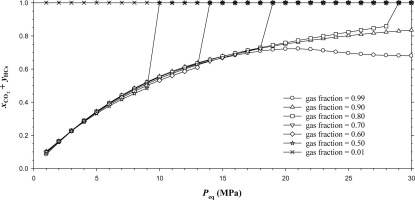当前位置:
X-MOL 学术
›
Int. J. Heat Mass Transf.
›
论文详情
Our official English website, www.x-mol.net, welcomes your
feedback! (Note: you will need to create a separate account there.)
A new analysis of pressure dependence of the equilibrium interfacial tensions of different light crude oil–CO 2 systems
International Journal of Heat and Mass Transfer ( IF 5.0 ) Pub Date : 2018-06-01 , DOI: 10.1016/j.ijheatmasstransfer.2018.01.014 Kaiqiang Zhang , Leng Tian , Lirong Liu
International Journal of Heat and Mass Transfer ( IF 5.0 ) Pub Date : 2018-06-01 , DOI: 10.1016/j.ijheatmasstransfer.2018.01.014 Kaiqiang Zhang , Leng Tian , Lirong Liu

|
Abstract In this paper, the equilibrium two-phase compositions are predicted and analyzed to elucidate the pressure dependence of the equilibrium interfacial tensions (IFTs) of three different light crude oil–CO2 systems. First, three series of the dynamic IFT tests for a dead light crude oil–pure CO2 system, a live light crude oil–pure CO2 system, and a dead light crude oil–impure CO2 system at different equilibrium pressures from the literature are used. Second, the modified Peng–Robinson equation of state (PR-EOS) is tuned by using measured pressure–volume–temperature (PVT) data to predict the equilibrium two-phase compositions of the three light crude oil–CO2 systems. Such tuned PR-EOS together with the parachor model is applied to predict the equilibrium IFTs, which are compared with and validated by the measured IFT data. Third, the pressure dependence of the equilibrium IFTs, the initial oil and gas composition effects, and the initial gas fraction effect are examined. The density difference between the light crude oil and gas phase is found to be a key factor in the parachor model for the IFT predictions. The equilibrium IFT vs. pressure curve is found to have three different pressure ranges, which correspond well to those for the density difference. Moreover, the initial oil and gas compositions affect the equilibrium two-phase compositions and IFTs to different extents. The live light crude oil–pure CO2 equilibrium IFT is reduced with an increased initial gas fraction. For the dead light crude oil–pure/impure CO2 system, the miscibility with zero IFT can be achieved only if the initial gas phase has more than 0.70 mol fraction. Otherwise, it is the complete gas dissolution into the light crude oil that leads to zero IFT.
中文翻译:

不同轻质原油-CO 2 系统平衡界面张力的压力依赖性新分析
摘要 在本文中,对平衡两相组成进行了预测和分析,以阐明三种不同轻质原油-CO2 系统的平衡界面张力 (IFT) 的压力依赖性。首先,使用文献中不同平衡压力下死轻质原油-纯 CO2 系统、活轻质原油-纯 CO2 系统和死轻质原油-不纯 CO2 系统的三个系列动态 IFT 测试。其次,通过使用测量的压力-体积-温度 (PVT) 数据来调整修正的彭-罗宾逊状态方程 (PR-EOS),以预测三种轻质原油-CO2 系统的平衡两相组成。这种调整后的 PR-EOS 与 parachor 模型一起用于预测平衡 IFT,并与测量的 IFT 数据进行比较和验证。第三,检查了平衡 IFT 的压力依赖性、初始油气成分效应和初始气体分数效应。轻质原油和气相之间的密度差异被发现是 IFT 预测的伞形模型中的关键因素。发现平衡 IFT 与压力曲线具有三个不同的压力范围,它们与密度差的那些范围很好地对应。此外,初始油气成分对平衡两相成分和IFTs有不同程度的影响。活性轻质原油-纯 CO2 平衡 IFT 随初始气体分数的增加而降低。对于死轻质原油-纯/不纯 CO2 系统,只有当初始气相的摩尔分数大于 0.70 时,才能实现零 IFT 的混溶。除此以外,
更新日期:2018-06-01
中文翻译:

不同轻质原油-CO 2 系统平衡界面张力的压力依赖性新分析
摘要 在本文中,对平衡两相组成进行了预测和分析,以阐明三种不同轻质原油-CO2 系统的平衡界面张力 (IFT) 的压力依赖性。首先,使用文献中不同平衡压力下死轻质原油-纯 CO2 系统、活轻质原油-纯 CO2 系统和死轻质原油-不纯 CO2 系统的三个系列动态 IFT 测试。其次,通过使用测量的压力-体积-温度 (PVT) 数据来调整修正的彭-罗宾逊状态方程 (PR-EOS),以预测三种轻质原油-CO2 系统的平衡两相组成。这种调整后的 PR-EOS 与 parachor 模型一起用于预测平衡 IFT,并与测量的 IFT 数据进行比较和验证。第三,检查了平衡 IFT 的压力依赖性、初始油气成分效应和初始气体分数效应。轻质原油和气相之间的密度差异被发现是 IFT 预测的伞形模型中的关键因素。发现平衡 IFT 与压力曲线具有三个不同的压力范围,它们与密度差的那些范围很好地对应。此外,初始油气成分对平衡两相成分和IFTs有不同程度的影响。活性轻质原油-纯 CO2 平衡 IFT 随初始气体分数的增加而降低。对于死轻质原油-纯/不纯 CO2 系统,只有当初始气相的摩尔分数大于 0.70 时,才能实现零 IFT 的混溶。除此以外,











































 京公网安备 11010802027423号
京公网安备 11010802027423号